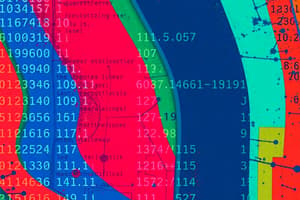Podcast
Questions and Answers
What are the three main language categories in computer programming, starting from the machine level?
What are the three main language categories in computer programming, starting from the machine level?
- Machine language, assembler, high-level language (correct)
- Machine language, high-level language, assembler
- High-level language, assembler, machine language
Assembly language is the most abstract way of writing program instructions.
Assembly language is the most abstract way of writing program instructions.
False (B)
What is the purpose of the "MOV" instruction?
What is the purpose of the "MOV" instruction?
- To compare two values.
- To multiply the contents of a register.
- To move data from one location to another. (correct)
What does the "LEA" instruction do?
What does the "LEA" instruction do?
What are the typical addressing modes used in assembly programming?
What are the typical addressing modes used in assembly programming?
Register indirect addressing allows data to be accessed only through a pointer register.
Register indirect addressing allows data to be accessed only through a pointer register.
What is the purpose of the "PUSH" and "POP" instructions?
What is the purpose of the "PUSH" and "POP" instructions?
Which instruction is used to exchange the contents of two operands?
Which instruction is used to exchange the contents of two operands?
Which instructions are used for input and output operations in assembly language?
Which instructions are used for input and output operations in assembly language?
What is the difference between a "JMP" and a "Jcond" instruction?
What is the difference between a "JMP" and a "Jcond" instruction?
What addressing mode combines both base and index addressing?
What addressing mode combines both base and index addressing?
What type of data structure is used to save return addresses in assembly language?
What type of data structure is used to save return addresses in assembly language?
The "CALL" instruction saves both the return address and the segment address.
The "CALL" instruction saves both the return address and the segment address.
How does a program transition from a higher-level language (like C) to machine code that the CPU can execute?
How does a program transition from a higher-level language (like C) to machine code that the CPU can execute?
What is the purpose of a compiler?
What is the purpose of a compiler?
What is a machine instruction, and what is its significance?
What is a machine instruction, and what is its significance?
Which part of the machine instruction specifies the operation to be performed?
Which part of the machine instruction specifies the operation to be performed?
A machine language instruction can be broken down into separate fields to represent various aspects of the instruction, such as the addressing mode and the destination register.
A machine language instruction can be broken down into separate fields to represent various aspects of the instruction, such as the addressing mode and the destination register.
What is the significance of the "D" field in a machine instruction?
What is the significance of the "D" field in a machine instruction?
What does the "W" field in a machine instruction represent?
What does the "W" field in a machine instruction represent?
Describe the purpose of the "MOD" field in a machine instruction.
Describe the purpose of the "MOD" field in a machine instruction.
Machine instructions are never influenced by any specific machine code generation rules.
Machine instructions are never influenced by any specific machine code generation rules.
Which addressing mode does the "MOV R(M), R(M)" instruction use?
Which addressing mode does the "MOV R(M), R(M)" instruction use?
Why is the "MOV Acc, M" instruction often more efficient compared to "MOV R(M), Data" while moving data from memory?
Why is the "MOV Acc, M" instruction often more efficient compared to "MOV R(M), Data" while moving data from memory?
Which instruction utilizes a sign extended version of the immediate value before performing the addition operation?
Which instruction utilizes a sign extended version of the immediate value before performing the addition operation?
Flashcards
Assembly Language Description
Assembly Language Description
The language closest to the machine's language, using symbolic representations of instructions and operands. It's user-friendly compared to machine language.
Machine Language Description
Machine Language Description
The language understood directly by the CPU, represented in binary code (0s and 1s). It's a low-level language with instructions for basic operations.
High-Level Language Description
High-Level Language Description
A programming language designed for human readability and ease of use. It requires translation into lower-level code (machine or assembly) before execution.
Compilation
Compilation
Signup and view all the flashcards
Assembly
Assembly
Signup and view all the flashcards
Register Addressing
Register Addressing
Signup and view all the flashcards
Immediate Addressing
Immediate Addressing
Signup and view all the flashcards
Direct Addressing
Direct Addressing
Signup and view all the flashcards
Based + Displacement Addressing
Based + Displacement Addressing
Signup and view all the flashcards
Indexed Addressing
Indexed Addressing
Signup and view all the flashcards
Based + Indexed Addressing
Based + Indexed Addressing
Signup and view all the flashcards
Arithmetic Instructions
Arithmetic Instructions
Signup and view all the flashcards
Logical Instructions
Logical Instructions
Signup and view all the flashcards
Transfer Instructions
Transfer Instructions
Signup and view all the flashcards
Control Instructions
Control Instructions
Signup and view all the flashcards
MOV Instruction
MOV Instruction
Signup and view all the flashcards
XCHG Instruction
XCHG Instruction
Signup and view all the flashcards
AND Instruction
AND Instruction
Signup and view all the flashcards
OR Instruction
OR Instruction
Signup and view all the flashcards
XOR Instruction
XOR Instruction
Signup and view all the flashcards
NOT Instruction
NOT Instruction
Signup and view all the flashcards
TEST Instruction
TEST Instruction
Signup and view all the flashcards
SHL Instruction
SHL Instruction
Signup and view all the flashcards
SHR Instruction
SHR Instruction
Signup and view all the flashcards
ADD Instruction
ADD Instruction
Signup and view all the flashcards
SUB Instruction
SUB Instruction
Signup and view all the flashcards
MUL Instruction
MUL Instruction
Signup and view all the flashcards
CMP Instruction
CMP Instruction
Signup and view all the flashcards
JMP Instruction
JMP Instruction
Signup and view all the flashcards
Jcond Instruction
Jcond Instruction
Signup and view all the flashcards
Signup and view all the flashcards
Study Notes
Architecture of Computers - L2ING - Chapter 3 - Notions about Computer Instructions
- This chapter covers machine language, assembler, and high-level languages.
- It also details usual machine instructions.
- Finally, it explains compilation and assembly principles.
Assembly Language
- Assembly language is a symbolic representation of machine language.
- It is closer to machine language than high-level languages.
- Instructions are symbolic and easier to understand than machine code.
- Each assembly instruction corresponds to a single machine instruction.
Common Machine Instructions
- Register Addressing: Uses CPU internal registers for source and destination.
- Example: MOV AX, BX
- Immediate Addressing: The operand is a value within the instruction itself.
- Example: MOV AX, 5
- Direct Addressing: The operand contains the address of the data in memory.
- Example: MOV AX, [1234H]
- Register Indirect Addressing (Based): Accesses data using a base register.
- Example: MOV AX, [BX]
- Register Indirect Addressing (Based+Dep): Uses a base register with displacement.
- Example: MOV AX, [BX+0002H]
- Register Indirect Addressing (Pointer): Uses a pointer register for accessing data.
- Example: MOV AX, [BP]
- Indexed Addressing: Similar to based addressing but uses SI or DI index registers
- Example: MOV AX, [SI]
- Indexed Addressing + Dep: Combines indexed addressing with displacement.
- Example: MOV AX, [BX+SI+0200H]
Common Machine Instructions - Interdictions
- Immediate values cannot be directly assigned to segment registers
- Example instructions include MOV Val_1, Val_2, MOV AL, BX, MOV DS, ES, MOV DS, 1000H, MOV Mot 1, Mot 2
Common Machine Instructions - Transfer Instructions (Loading, Storage)
- Allows data movement from one location (source) to another (destination)
- Register to register
- Register to memory
- Memory to register
- Instructions include: MOV, PUSH, POP, XCHG, IN, OUT, LEA
Common Machine Instructions - Logical (bit) Instructions
- Basic logical operations like AND, OR, NOT, XOR, TEST and bit shifts SHL, SHR
- Example: AND Destination, Source
Common Machine Instructions - Arithmetic Instructions
- Basic arithmetic operations like ADD, SUB, MUL, CMP
- ADD is for addition, SUB is for subtraction, MUL is for multiplication, CMP is for comparison.
- Example instructions add AX, [1234H]
Common Machine Instructions - Jump or Plug Instructions
- JMP: Unconditional jump.
- Jcond: Conditional jump, jumps to Label if a condition (cond) holds true.
- Example conditional jump instructions include JZ, JNZ, JE, JNE, JA, JAE, JB, JBE, JG, JGE, JL, JLE, LOOP etc.
Stack Segment/SS
- Part of central memory, follows LIFO (Last-In, First-Out) principle.
- It has special purpose registers,like SP (Stack Pointer) and SS (Stack Segment)
- Used for procedure calls, returns, temporary storage, and data handling.
- Methods of use include explicit (PUSH, POP) and implicit (procedure calls, returns).
- Explicit and implicit usages are through method calls and returns
Compilation and Assembly Principles
- High-level language code is converted into assembly language and then to machine code (0s and 1s).
Studying That Suits You
Use AI to generate personalized quizzes and flashcards to suit your learning preferences.




